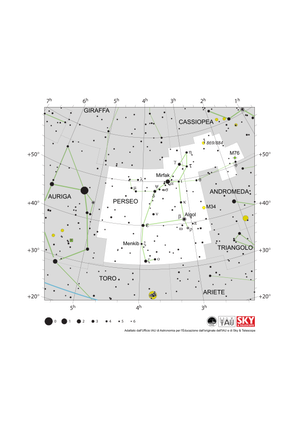Termine del Glossario stella variabile
Descrizione Una stella variabile è una stella che mostra agli osservatori marcati cambiamenti di luminosità nel tempo. La luminosità di tutte le stelle cambia nel corso di milioni o miliardi di anni a causa dell'evoluzione stellare. Il termine stella variabile è tipicamente riservato alle stelle la cui luminosità varia su scale temporali molto più brevi rispetto alle loro scale temporali evolutive.
Esistono diversi possibili meccanismi fisici che possono portare alla variabilità. Alcune stelle, come le Cefeidi o le RR Lyrae, sono instabili e pulsano, cambiando periodicamente dimensioni e luminosità.
Altre stelle possono espellere materiale brillante che aumenta la luminosità complessiva osservata ("variabili eruttive"). Le stelle chiamate variabili cataclismiche o novae mostrano un improvviso aumento di luminosità seguito da un ritorno al livello precedente. In questi sistemi, lo scenario coinvolge una coppia di stelle, con la materia di una che fluisce sull'altra fino ad accendere una reazione di fusione nucleare non appena viene raggiunta una certa soglia. Una delle due stelle quindi subisce un'esplosione cataclismica ed un improvviso aumento della luminosità. Altre stelle appaiono variabili perché ruotano, mostrandoci alternativamente un lato più luminoso e uno meno luminoso, oppure perché in realtà sono due stelle che orbitano l'una intorno all'altra, con la stella più luminosa che periodicamente si eclissa dietro la compagna meno luminosa. Questi ultimi sistemi sono noti come binarie a eclissi.
Termini correlati
- Variabile Cefeide
- Nova
- Fusione nucleare
- Evoluzione stellare
- Macchia solare
- Supernova
- Nana Bianca
- accrescimento
Vedi questo termine in altre lingue
status del termine e della definizione La definizione originale di questo termine in inglese é stata approvata da un ricercatore astronomo e da un docente La traduzione di questo termine e della sua definizione sono state approvate da un ricercatore astronomo e da un docente
Il Glossario Multilingue OAE é un progetto dell'Ufficio IAU per la didatticadell'astronomia (OAE) in collaborazione con l'ufficio IAU OAO per la DivulgazioneAstronomica (OAO). I termini e le definizioni sono stater scelte, scritte eriviste da un impegno collettivo da parte di OAE, i Centri e i Nodi OAE e iCoordinatori Nazionali per la Didattica dell'Astronomia e da altri volontari.Potete trovare una lista completa dei crediti, Tutti i termini del glossarioE le definizioni sono pubblicate su Creative Commons CC BY-4.0 licenza e dovrebbero essere accreditate ad IAU OAE.
Se noti un errore di fatto o di traduzione in questo termine del glossario, per favore contattaci.
Diagrami correlati
Mappa della costellazione di Orione
Crediti: Adattato dall'Ufficio IAU di Astronomia per l'educazione dall'originale di IAU/Sky & Telescope
License: CC-BY-4.0 Creative Commons Attribuzione 4.0 Internazionale (CC BY 4.0) icone
Mappa della costellazione dello Scorpione
Crediti: Adattato dall'Ufficio IAU di Astronomia per l'educazione dall'originale di IAU/Sky & Telescope
License: CC-BY-4.0 Creative Commons Attribuzione 4.0 Internazionale (CC BY 4.0) icone
Mappa della costellazione della Balena
Crediti: Adattato dall'Ufficio IAU di Astronomia per l'educazione dall'originale di IAU/Sky & Telescope
License: CC-BY-4.0 Creative Commons Attribuzione 4.0 Internazionale (CC BY 4.0) icone
Mappa della Costellazione Carina
Crediti: Adattato dall'Ufficio di Astronomia per l'Educazione della IAU dall'originale della IAU e di Sky & Telescope.
License: CC-BY-4.0 Creative Commons Attribuzione 4.0 Internazionale (CC BY 4.0) icone
Mappa della costellazione di Perseo
Crediti: Adattato dall'Ufficio di Astronomia per l'Educazione della IAU dall'originale della IAU e di Sky & Telescope.
License: CC-BY-4.0 Creative Commons Attribuzione 4.0 Internazionale (CC BY 4.0) icone













